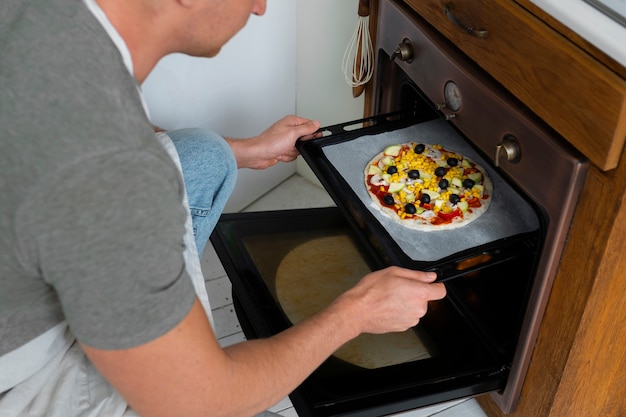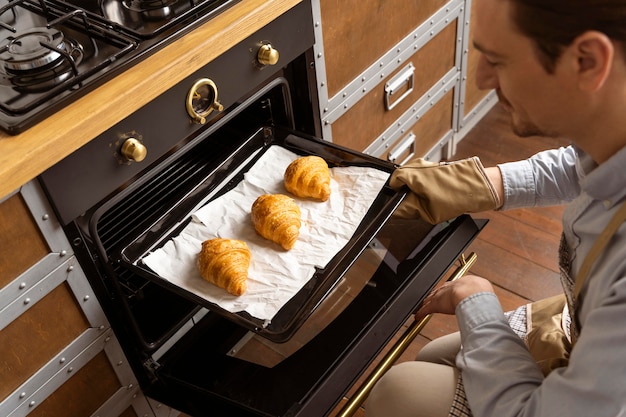Hard-boiled eggs – those humble little spheres of protein – are a kitchen staple for a reason. They're a quick and easy breakfast, a perfect addition to salads and sandwiches, and a versatile ingredient for countless recipes. But getting them just right – with a perfectly firm yolk and no unsightly green ring – can feel like a culinary lottery. I've spent years experimenting with different methods, from the classic stovetop simmer to those fancy egg cookers, but nothing seemed to consistently deliver the results I craved. Then, one day, I stumbled upon a game-changer: the microwave.
Yes, you heard me right – microwaving eggs! Initially, the idea seemed crazy, bordering on sacrilegious. But the online buzz surrounding this method was undeniable. I decided to give it a shot, and I haven't looked back since. It's fast, it's foolproof, and it consistently produces those beautifully cooked hard-boiled eggs I've always dreamed of. Let me tell you, the microwave has become my new kitchen hero.
(Part 1) The Microwave Method: Simplicity Meets Perfection

My first attempt at microwaving eggs was met with a healthy dose of skepticism. I cautiously followed the online instructions, amazed by how simple it was. And when I tasted the results – a perfectly cooked egg with a firm yolk and a smooth, creamy texture – my skepticism vanished completely. I was a convert.
The Microwave Method: Step-by-Step
- Gather your tools: You'll need a microwave-safe bowl or mug, a plate, and a clean kitchen towel.
- Prepare your eggs: Carefully crack each egg into the bowl. I find it helpful to use a small spoon to gently separate the yolk from the white without breaking it.
- Add water: Pour enough water into the bowl to completely cover the eggs. Don't worry if the eggs float a bit; this is normal.
- Wrap it up: Cover the bowl with the kitchen towel. This helps create a steamy environment, ensuring even cooking and preventing the eggs from drying out.
- Microwave: Now comes the magic! Microwave the eggs on high for 1 minute per egg. For example, three eggs would need 3 minutes of cooking time.
- Let it rest: Once the microwaving is done, let the eggs rest in the bowl for 5-10 minutes before peeling. This allows the eggs to cool down gently, making peeling much easier.
And that's it! It truly is as simple as it sounds. No more worrying about boiling water, timing, or overcooked yolks.
(Part 2) Unlocking the Secrets: Tips and Tricks for Microwave Success

While the microwave method is incredibly straightforward, there are a few key tips and tricks that can elevate your hard-boiled egg game. These little details make a world of difference in ensuring consistent, perfect results.
The Importance of fresh eggs:
Freshness matters, my friends. Older eggs tend to have larger air pockets, which can lead to uneven cooking and even explosive results in the microwave. It's not a pretty sight, and it can be messy. Always use the freshest eggs you can find, preferably within a week of their laying date.
Preventing Explosions:
You might have heard horror stories about eggs exploding in the microwave. It's a genuine concern, but usually, it happens due to faulty eggs or not enough water in the bowl. To minimize the risk:
- Use fresh eggs: As mentioned above, fresh eggs are less likely to explode.
- Ensure sufficient water: Make sure the eggs are completely submerged in water. The water helps create steam and prevents the eggs from overheating.
- Pierce the egg: If you're feeling extra cautious, you can pierce the top of each egg with a pin before microwaving. This releases some of the internal pressure and reduces the risk of an explosion. However, I find this step to be unnecessary with fresh eggs and adequate water.
Adjusting for Your Preferred Texture:
Everyone has their own hard-boiled egg preferences. Some like their yolks runny, while others prefer them firm. The beauty of the microwave method is its flexibility. You can adjust the cooking time to achieve your desired texture. Here's a handy guide:
| Cooking Time | Yolk Texture |
|---|---|
| 1 minute per egg | Soft-boiled, runny yolk |
| 1.5 minutes per egg | Medium-boiled, creamy yolk |
| 2 minutes per egg | Hard-boiled, firm yolk |
Don't be afraid to experiment! You can always fine-tune the cooking time based on your preference. Over time, you'll discover the perfect timing for your taste.
(Part 3) Beyond Basic Hard-Boiling: Embracing Flavor and Creativity

Now that you've mastered the basic microwave method, let's explore the world of possibilities. Hard-boiled eggs are incredibly versatile, offering a blank canvas for creativity in the kitchen.
Adding Flavor:
Plain hard-boiled eggs are delightful on their own, but why settle for ordinary when you can elevate them with a burst of flavor? Here are a few simple ways to add a touch of magic:
- Spices: A pinch of spices can transform the flavor profile of your eggs. Try adding turmeric for a vibrant yellow hue and a slightly earthy flavor, black pepper for a subtle kick, or even a touch of cinnamon for a warm, sweet aroma.
- Herbs: Infuse your eggs with the earthy aroma of herbs by adding fresh or dried herbs to the water before microwaving. Rosemary, thyme, dill, and even a sprig of parsley can add a wonderful depth of flavor.
- Vinegar: A splash of vinegar in the water serves two purposes: it helps prevent the eggs from cracking and adds a subtle tang to the finished product. It's a secret weapon for perfectly smooth, flavorful eggs.
Crafting Exquisite deviled eggs:
Deviled eggs – a classic party staple and a beloved appetizer – are incredibly easy to make with perfectly cooked hard-boiled eggs from the microwave. Here's how:
- Peel and slice: Carefully peel the hard-boiled eggs and cut them in half lengthwise.
- Scoop out the yolks: Use a spoon to scoop out the yolks and place them in a bowl.
- Mash and mix: Mash the yolks with a fork and add your favorite deviled egg ingredients. Mayonnaise, mustard, chopped gherkins, chopped onions, paprika, and a sprinkle of salt and pepper are all classic additions. Feel free to get creative with your own unique combinations!
- Fill the egg whites: Spoon the yolk mixture back into the egg white halves.
- Decorate and serve: Sprinkle with paprika, chopped parsley, or a few chives for a finishing touch. Chill for at least 30 minutes before serving for maximum flavor and texture.
Deviled eggs are a testament to the versatility of hard-boiled eggs, a simple ingredient transformed into a culinary masterpiece.
(Part 4) Peeling Made Easy: The Secret to Effortless Shell Removal
Let's face it, peeling hard-boiled eggs can be a frustrating experience. Those stubborn bits of shell clinging to the egg white, the dreaded green ring around the yolk – it can be a real test of patience. But fear not, there's a simple trick to make peeling a breeze.
The Cold Water Method:
Immediately after microwaving, submerge the eggs in a bowl of ice-cold water for 10-15 minutes. This rapid cooling helps the egg shrink slightly and creates a space between the shell and the egg white, making peeling much easier.
Bonus Tip:
Once the eggs have cooled, gently tap the bottom of the egg on a hard surface. This creates tiny cracks in the shell, allowing the shell to easily peel away in large pieces.
(Part 5) Demystifying the Green Ring: Myth vs. Reality
The green ring around the yolk – that unsightly halo that often accompanies overcooked eggs – has long been a source of culinary anxiety. But what is it really, and is it dangerous?
The green ring is actually a result of a chemical reaction between the iron in the yolk and the sulfur in the egg white. It happens when eggs are overcooked, allowing these elements to interact. While it might look unappetizing, it's perfectly safe to eat. However, it's not particularly appealing, and most of us prefer our hard-boiled eggs without this green ring.
Preventing the Green Ring:
The best way to prevent the green ring is to avoid overcooking the eggs. The microwave method allows for flexibility, so you can adjust the cooking time to ensure your eggs are cooked to your desired level of doneness.
Another helpful tip is to add a splash of vinegar to the water before microwaving. The vinegar helps the egg white solidify faster, minimizing the time for the iron and sulfur to react.
(Part 6) The Great Hard-Boiled Egg Debate: Stovetop vs. Microwave
For years, the culinary world has been divided over the best method for hard-boiling eggs: the classic stovetop method or the microwave method. Each method has its proponents and detractors, and the debate continues to rage on. But which one comes out on top?
Stovetop Method: The Traditional Approach
The stovetop method is the traditional way to hard-boil eggs, a technique passed down through generations of cooks. It involves gently simmering the eggs in a pot of water.
- Pros: It's a tried-and-true method, often considered more reliable. You have greater control over the temperature and cooking time, allowing for more precise results.
- Cons: It takes longer than the microwave method, and you need to keep a watchful eye on the eggs to prevent overcooking. Getting the timing perfect can be tricky, leading to unevenly cooked eggs and those dreaded green rings.
Microwave Method: The Modern Marvel
The microwave method, as we've explored, is all about speed, efficiency, and consistent results. It's a modern culinary marvel that has revolutionized the way we hard-boil eggs.
- Pros: It's incredibly fast and easy. You don't need to worry about timing or constantly monitoring the eggs. It consistently produces perfectly cooked eggs with a firm yolk and no green ring.
- Cons: Some people find the idea of microwaving eggs unsettling. It might not be the ideal method for large batches of eggs, as a larger volume of water can be difficult to manage in a microwave-safe bowl.
My Verdict: The Microwave Takes the Crown
As someone who has experimented with both methods extensively, I'm firmly in the microwave camp. The speed, ease, and consistent results have won me over. It's simply the best way to get perfect hard-boiled eggs every time. The microwave has become my go-to method for consistently delicious hard-boiled eggs.
(Part 7) Beyond the Basics: Unveiling the Culinary Versatility of Hard-Boiled Eggs
Hard-boiled eggs are so much more than just a simple breakfast staple. They're a versatile ingredient that can be incorporated into countless recipes and dishes, adding protein, flavor, and texture.
Salads: A Classic Pairing
Chopped hard-boiled eggs are a classic addition to salads, adding protein, texture, and a satisfying bite. They complement a wide range of salads, from simple egg salads to Greek salads to hearty chicken salads.
Sandwiches: Elevating the Ordinary
Elevate your sandwiches with the addition of hard-boiled eggs. They add a protein punch, a satisfyingly creamy texture, and a delightful savory note. A classic egg salad sandwich is a lunchtime favorite, and a simple egg and cheese sandwich with a few slices of tomato makes for a quick and healthy meal.
Soups and Stews: Adding Depth and Texture
Hard-boiled eggs can be added to soups and stews for a boost of protein and a unique texture. They're particularly delicious in hearty soups like minestrone or lentil soup, adding a delightful contrast to the other ingredients.
Snacks: A Healthy and Convenient Choice
Hard-boiled eggs make a perfect on-the-go snack. They're packed with protein, healthy fats, and vitamins, making them a nourishing and satisfying choice. They're a great way to satisfy those mid-afternoon cravings or to keep you feeling full and energized on the go.
(Part 8) FAQs: Common Questions and Answers
1. Can I microwave more than one egg at a time?
Absolutely! The key is to add 1 minute of cooking time per egg. For example, three eggs would need 3 minutes of cooking time. You can even microwave a dozen eggs at once, but be sure to use a large enough microwave-safe bowl and adjust the cooking time accordingly.
2. What if I don't have a microwave?
If you don't have a microwave, you can still make hard-boiled eggs using the traditional stovetop method. Bring a pot of water to a boil, add the eggs carefully, and simmer for 10-12 minutes. Then, immediately submerge the eggs in cold water to stop the cooking process.
3. Can I use this method for other types of eggs, like duck eggs?
The microwave method works best for chicken eggs. Duck eggs have a thicker shell and a larger air pocket, which can make them harder to cook evenly in the microwave. For duck eggs, it's best to stick with the stovetop method.
4. What if my egg explodes in the microwave?
While it's rare, egg explosions can happen. The most likely culprit is an older egg with a large air pocket. Always use fresh eggs and ensure there's enough water covering the eggs. You can also pierce the egg with a pin before microwaving to release some of the pressure. However, with fresh eggs and adequate water, this is usually unnecessary.
5. What if I overcook my eggs?
If you've overcooked your eggs, they will have a very hard yolk and may even have a green ring around it. While it's perfectly safe to eat, the texture might not be ideal. Next time, try reducing the cooking time slightly to achieve your desired texture. Experiment to find the perfect cooking time for your preference.
There you have it! The microwave method for hard-boiled eggs – a simple, quick, and foolproof way to get those perfect, perfectly cooked eggs every time. So, ditch the stovetop, embrace the microwave, and enjoy the versatility of these culinary gems. From breakfast to snacks, salads to deviled eggs, the possibilities are endless! Happy cooking!
Everyone is watching

How to Cook Frozen Lobster Tails Perfectly: A Step-by-Step Guide
RecipesLobster. Just the word conjures up images of lavish meals, special occasions, and a taste of luxury. But let's...

Pork Fillet Cooking Time: How Long to Cook It Perfectly
RecipesPork fillet, or tenderloin as it's sometimes called, is a real favourite in our house. It's so versatile, and...

Pigs in a Blanket Cooking Time: How Long to Bake for Perfect Results
RecipesAh, pigs in a blanket. Just the name conjures up images of those delightful little parcels of crispy pastry en...

The Ultimate Guide to Cooking Delicious Frankfurters
RecipesLet's face it, we all love a good frankfurter. It's a classic, simple, and always satisfying. But let's be rea...

Wolf Meat Recipes: A Guide to Cooking Wild Game
RecipesLet's be honest, you don't see wolf meat at your local butcher shop every day. It's a bit of a wild card, but ...
